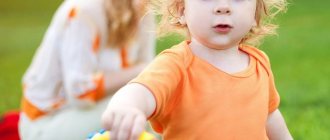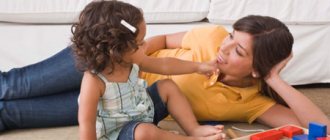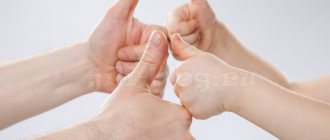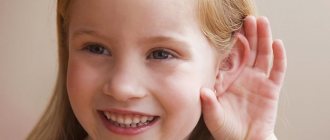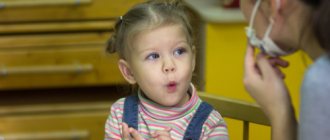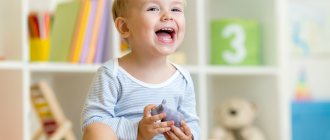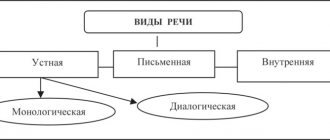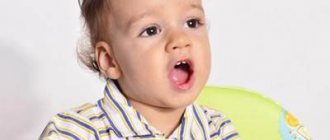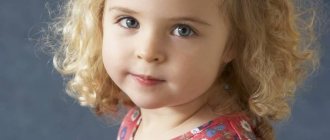Article:
Learning to speak correctly and convey thoughts in words is one of the most necessary skills that a baby should acquire in his first 2 years of life.
Teaching a child to speak by the first 2 years is one of the main tasks for parents. At this age, children can already be sent to kindergarten, and if the baby does not speak at all or speaks very poorly, it will be difficult for him to communicate with peers in kindergarten. In addition, it will be much easier for parents to understand their child if he speaks well. Talking babies are calmer and less subject to whims, because they can verbally explain to their parents what they need, and parents, in turn, can quickly satisfy the child’s needs and desires. If you wish your beloved child happiness and future success, help him learn to put his thoughts and emotions into words, and the sooner the better. This must be done from the very birth of the baby, because during this period for him the mother’s voice is the most desirable sound in the Universe. The child listens and hears at this time. However, not all parents believe that a child should be taught to speak from birth, justifying this by the fact that, they say, the time will come - he will learn on his own... And this is a big misconception. Quite often, it is very difficult to convince a mother that it is necessary to develop a child’s speech as early as possible, but perhaps after reading this article, parents will reconsider their attitude to the question of whether it is necessary to teach a child to speak from an early age. Well, for those parents who have no doubt that it is necessary and very important to develop their child’s speech, we will give some useful recommendations that will help build the right dialogue with the baby and turn any activity into an entertaining game.
“Talk to me, mom” - how to develop a child’s speech
The development of a child’s speech is a goal that a mother should set for herself while still pregnant. Experts have long proven the fact that a baby, while in the tummy, is able not only to hear, but also to distinguish a large number of sounds. Moreover, he may like some, while others, on the contrary, frighten him or cause irritation. Neonatologists often advise expectant mothers to read fairy tales and nursery rhymes, sing lullabies to their unborn baby, and play classical music. All this contributes to the development of the child’s hearing and speech apparatus. And his mother’s voice is the sweetest sound for him.
After birth, it is the mother’s speech that can evoke the strongest emotions in the newborn. He does not yet understand the words addressed to him, but he perfectly recognizes the voice itself and learns to distinguish intonations. To do this, you need to constantly talk to your baby when he is awake. Only in this way will the child’s passive vocabulary be replenished. Moreover, the more varied the communication with the mother and other loved ones, the faster the baby will speak. Speech therapists and pediatricians believe that a child begins to speak only when his passive vocabulary is replenished with the required number of words. Therefore, responsibility for the development of the baby’s speech lies entirely with his parents.
I would also like to note that all children are individual. Moms and dads have a tendency to compare their baby with other children. This should not be done, because some babies begin to talk earlier than they walk - at nine to ten months, while others remain silent until a year or two, not considering it necessary to start a conversation. Both may be normal variants. Therefore, be attentive to the successes of your baby and focus on them, setting new goals and objectives for the baby. However, remember that the centers in the parts of the brain responsible for the speech apparatus are finally formed in children by the age of three. This means that parents do not have much time to help their baby develop his speech and ability to speak well.
First generalizations
Gradually, the baby establishes a connection not only between a specific object and a word, but also between other similar objects and this word. How does this happen?
Here, for example, is an experiment that was conducted by psychologists with young children.
The experiment involved two groups of children aged from 1 year to one year and 3 months. In the first group, each child for two months, almost every day, was shown an unfamiliar object - a book - 10 times for five seconds and said: “Book! Book!" Each time the children turned their gaze and turned their heads towards the object. During the observation period, this reaction was repeated 500 times.
With the children of the second group, one book was also used, but the child, under the guidance of an adult, performed various actions with it. “Here is a book!”, “Open the book!”, “Close the book!” etc. The kids were given only 20 different commands; each of them included the word “book”, and each required a specific motor response. These motor reactions were repeated only 50 times during the entire observation period.
Control tests were then carried out in both groups. During these tests, many different objects were laid out in front of the child: cubes, dolls, toy animals, several books that differed in size, thickness, cover color, etc. The adult addressed the child with the words: “Give me the book!” It was important to find out which book the child would choose. Only the one he saw before, or any other, uniting the objects with the concept of “book”? Children from the first group took only one book - the one they had seen during the previous two months - and gave it to the experimenter. When they were asked to take another book, they either took the first object they came across (it could be a doll, a hare, etc.) or did nothing. This means that for the children of this group the word “book” remained the name of one specific object and did not acquire a general meaning. So a large number of repetitions, even with the simultaneous presentation of the corresponding object, does not yet contribute to the development of generalization.
And therefore, teach your baby to act with various objects, be sure to name these actions out loud. You can bring the same book, show it to the doll, open it, close it, leaf through it, put it on a chair, find an interesting picture in it, etc. Contact your baby more often with various simple requests. He will be very happy to help you, and at the same time he will enrich his vocabulary and gain the first experience of generalization.
Speech norms for children under three years of age
Despite the fact that the process of speech development is individual, there are certain average standards that allow parents to move in the right direction. Moms and dads should know that at every age the baby acquires new skills. This also applies to speech. If a few months after birth he can reproduce at most three or four sounds, then by 8-9 months he already begins to put them into syllables that resemble simple words. Most often, they have no relationship with the objects that represent them. However, some babies pronounce these sounds quite consciously, which indicates a high level of their development. For example, at 9 months a child can already pronounce the syllables -pa, -ba, -dya, -da and, accordingly, can address dad or grandma using these syllables. Many parents eagerly wait for their baby to consciously say the word “mom.” Unconsciously, the baby can pronounce the syllable -ma at 7 and 6 months, but, consciously, the word “mother”, as a rule, begins to be spoken later - by 10-11 years, and some even after a year. Mom should not be upset about this, because everything is individual. Some children may already be saying several words before they even say the word "mama" for the first time.
Speech development norms for children depend on age limits. In our article we will talk about what and how a baby should speak at one, two and three years old:
Stage one: first words
From a year to a year and a half, the baby begins to move very actively in space and accumulate new experiences. This experience is necessarily reflected in speech development.
Usually the first words appear at the age of 9.5 months - 1 year 6 months. Most often they designate the closest people: mother, father, woman, uncle, aunt. The baby can easily reproduce onomatopoeic words: aw-aw (dog), tick-tock (clock), mu-mu (cow), etc. Often, instead of a whole word, a child pronounces an initial or stressed syllable (ko instead of cat or bura instead of Cheburashka). But since these “words” mean specific things and are pronounced in a certain situation (at the sight of a cat or Cheburashka), we can call them words, and not random syllables.
It has been noticed that some children “love” nouns denoting objects and people more, while others prefer verbs associated with social interaction – “go away”, “want”, “give”, etc.
The first words have a broad generalized meaning. However, this is not at all the generalization that we are used to when calling a doll, a bear and a ball as toys. For now, the child singles out one feature and combines a variety of things based on it. So, the word “yum-yum” is used by a one-year-old child to describe all kinds of food, as well as the dishes from which he is fed. When he gets hungry, he also shouts “Yum-yum!” (=I’m hungry!), and when he sees a teenager chewing gum on the street, he comments: “yum-yum” (=eating).
Little Lisa used the word “una” (moon) to call all round-shaped objects - pancakes, round spots on window glass, circles in books, postmarks on envelopes, round embossed frames on book bindings, the letter “O”. And Fedya decided to generalize the sounding objects. The word “ko-ko”, which at first in his dictionary meant a crowing rooster, Fedya began to call the sounds of a violin, piano, accordion, any music and musical toys. Texture can also become a general principle: the word “woof-woof” was used by Katyusha not only for a dog, but also for all furry animals, soft slippers, and even a photograph of an old man in a fur coat.
Child's speech in the first year of life
From the very first day after birth, the baby talks to his parents in the only way possible for him - through screaming and crying. Thus, he communicates that he is hungry, cold, upset, feels afraid, or is simply bored and craves his mother’s attention. Around one month, parents begin to distinguish their baby's vocal signals. He shouts with different intonations depending on what he wants to achieve.
If the baby’s development is proceeding correctly, then at two months old the baby will begin to happily make various sounds, while blowing bubbles and smiling. His favorite sounds are vowels: “a”, “o”, “u”. Many children pronounce something resembling “gu” in addition to them. That’s why we quite often hear such a cute “aha” from the baby. The baby repeats sounds sometimes for several minutes in a row, while actively gesturing with his arms and moving his legs.
The time interval from three to six months is marked by humming. The baby begins to repeat the simplest syllables, and it is important for parents not to miss the beginning of the development of his speech. During this period, it is recommended to include songs, audio books for the baby, read fairy tales and poems, and also voice everything that happens around the baby. Comment on everything you do. Don’t think that the baby doesn’t understand anything yet and therefore doesn’t need explanations. The baby is interested in all your words, especially if they are a dialogue. At the age of 3-4 months, a child is able to listen to someone else’s speech for a long time, literally absorbing every word. And at the moment of your silence, the baby successfully fills the pauses in the conversation with his humming, thereby showing interest in communication.
At about five months, the baby begins to babble. Many parents recognize familiar words in this set of sounds and syllables and are very happy about the high level of development of their child. However, in fact, these are unconscious sounds and syllables that are in no way associated with certain objects or people.
At seven to eight months, children usually understand spoken language well. Moreover, they understand not only frequently repeated words, but also entire phrases. For example, the mother’s phrase “let’s go for a walk” can cause great delight in the baby, and “let’s eat” can make the baby open his mouth wide. The child is able to remember the names of toys or animals, and when a particular object is mentioned, he can find it with his eyes.
By the age of one year, most children already speak their first words. Mostly their vocabulary consists of a small number of short words. The average child is fluent in five to ten words and this is considered the norm.
Why does a first-grader need a speech therapist: speech disorders and school work
Problems with speech development appear exclusively in childhood, and the last “chance” to encounter them is first grade. During this period, difficulties “preserved” from an early age can manifest themselves as dysgraphia (impaired written language) or dyslexia (impaired reading - the brain cannot transform incomprehensible graphic images into letters and, as a result, read the word correctly).
As a rule, these deviations become obvious by the end of the first grade. If a child has difficulty mastering competent writing and reading, he is inattentive (does not write the endings, starts writing from the second syllable, confuses the letters “d” and “b”, “m” and “n” and others), there is no point in hiring him a tutor. It is very possible that the issue is a speech deviation, which can be corrected with the help of speech therapy sessions.
Article provided by OsteoPolyClinic
Speech development of a child at 2 years old
After a child turns one year old, his vocabulary begins to rapidly expand. The child becomes incredibly curious and literally absorbs all new words. The baby perfectly understands most of what is said to him, and by the age of one and a half years he speaks about thirty words.
At approximately the same age, children learn to correctly use cases and inflect words. This is an important stage in the development of speech, so the main task of parents is to maintain interest in communication and teach the child to correctly pronounce and decline certain words. You can also develop your child’s speech with the help of colorful books. It’s good if they have three-dimensional pictures, since the baby still receives a lot of information through tactile sensations.
By the age of two, as a rule, a baby can pronounce from seventy to one hundred words. And now parents can develop his speech skills with various games and special exercises.
Physical development
Parents may worry if the child is too thin or, conversely, overweight, however, the main thing is that he continues to grow at a stable pace.
At 2 years, in addition to growth, you will also notice obvious changes in the baby’s appearance. Body proportions begin to change. Children's muscles become stronger and, if previously the baby had a round, plump tummy and short arms, now in terms of body structure he becomes more like a preschooler than a baby.
Physical skills and movement
At this age, children can run and fall noticeably less.
At 2 years old a child can:
- jump on the spot;
- ride a tricycle;
- recognize objects and name them (if he doesn’t speak yet, then point them with a pen);
- climb and descend stairs almost independently, sometimes using an adult’s hand or stair railings for balance;
- kick and catch the ball;
- stand on one leg for a few seconds;
- stand on tiptoes;
- run;
- climb on and off furniture independently;
- pulling toys on a broken string while walking.
Be there while your little one explores the world. This will make the child feel safe. With your support now, he will be able to confidently start something new in the future.
Safety
When your baby is so active, it's a good idea to think about his safety in the home. Check if you have taken care of all the points:
- All dangerous items, including medicines and washing powders, are kept high under lock and key.
- Furniture and TVs are securely attached to the wall. Even if a tall cabinet or chest of drawers seems very heavy and unliftable to you, a child can easily knock it over.
- Set the hot water temperature in the tap to no more than 50°C, if possible.
- Always supervise children near water.
- Install locks on the windows and do not leave your child in a room with an open balcony or window.
For the safety of the little ones, you can use a GPS watch. By connecting them to the “Where are my children” application, you will always be calm about your child. The presence of a geo-tracker and the Surround Sound function will tell you how the baby is doing if you left him with a nanny for a while or if the baby started going to nursery.
Fine motor skills
Two-year-olds already enjoy playing with small objects. This helps develop fine motor skills.
The child can:
- string beads onto a cord;
- collect small items in containers;
- turn the pages of books;
- collect a pyramid;
- unfasten Velcro and zippers;
- hold a spoon, fork, comb.
When playing and practicing with small objects, do not leave your baby alone - he may swallow them or put them in his nostril or ear.
Weight and height
In the second year of life, growth and weight gain slow down noticeably. Moreover, boys are on average 0.8-1 kg heavier than girls and slightly taller.
When comparing your child’s performance with the generally accepted ones, it is important to remember: all children are different. As a rule, there is no need to panic if there is a slight deviation from the norm . Moreover, during visits to the pediatrician, the doctor still continues to measure the weight and height of the baby every time.
Analyze your baby's height and weight:
| Indicators of girls at 2 years old | Indicators of boys at 2 years old | ||||||
| Weight, kg) | Height (cm) | Weight, kg) | Height (cm) | ||||
| Lower border and upper | Norm | Lower border and upper | Norm | Lower border and upper | Norm | Lower border and upper | Norm |
| 8,1-13 | 11,5 | 76,7-89,6 | 86,4 | 8,6-15,3 | 12,2 | 78,3-93,6 | 87,5 |
⠀ Although boys tend to be larger than girls, such important parameters as chest and head circumference are not yet very different. On average, at 2 years old, a boy’s head circumference should be about 47.5 cm, and his chest circumference should be 48.5 cm. For girls, the norm for head circumference is 46.5 cm, and chest circumference is 48.5 cm.
Sense organs
At 2 years old, the baby pays attention to everything around him. The child is interested in bright colors and different textures. He can already distinguish objects by shape, size and color. The senses help him understand the world.
Vision
At this stage of development, children receive the main information through vision. At 2 years old, they can distinguish primary colors, and from 2 to 3 years old they begin to see pale and pastel shades. At the same time, it is still difficult for them to coordinate the visual system. For example, if a child loses sight of his mother in a crowd, he will not be able to quickly find her.
Develop your child's observation skills - this will improve his fantasy and imagination. And don’t forget about a scheduled visit to a pediatric ophthalmologist at age 2.
Touch
Tactile perception is now very important for the baby. The sense of touch helps him distinguish between soft and hard objects, hot and cold, as well as various textures (rough, ribbed, soft, velvet, etc.)
Hearing
Children at the age of 2 already perfectly understand the intonation with which an adult speaks. Also, kids immediately perceive familiar songs or rhymes by ear.
Loud noises are unpleasant for the baby. Try not to overload the child’s psyche with them. If this happens, let him rest in silence.
Smell and taste
Still at 2 years old, children often explore objects by placing them in their mouths. At the same time, the child is already able to distinguish between sweet and salty, sour and bitter. Also, the baby successfully remembers the characteristic taste of a particular product, the memory of which will remain for a long time. This will influence the formation of the baby’s taste preferences in the future.
Try to feed your child a variety of foods. The sooner he learns to recognize tastes, the better for the development of his sensory system.
Development of baby's speech in the third year of life
From two to three years of age, a child’s vocabulary rapidly develops. The norm for speech development for children of this age is considered to be proficiency in one thousand words and two hundred phrases. In the third year of life, children begin to use pronouns and confidently decline words by case. Children at this age can sing songs and recite short rhymes.
By the age of three, the baby can already speak in coherent sentences, and parents should constantly encourage him to do this. The most effective technique is asking questions. It is to build a dialogue with as many questions as possible. Moreover, it is very important that they cannot be answered in monosyllables. In this way, the baby’s vocabulary expands, he learns to construct phrases correctly and use new words in conversation.
At three years old, children pronounce most sounds unclearly, which should not cause concern to parents. The fact is that by the age of three the speech apparatus is not yet fully formed and certain sounds are very difficult to pronounce. Usually by the age of five the situation is corrected without the intervention of speech therapists. However, we would like to note that children distort some words not because they cannot pronounce this or that letter, but simply because the child does not understand how to pronounce this word correctly. And having memorized it once, they subsequently pronounce the word with distortion of sounds. In this case, parents should correct the baby and not be lazy to explain how to correctly pronounce this or that word. If the problem is deeper, then after 5 years a speech therapist should deal with it.
Self-diagnosis of delay
It is better to plan diagnostic measures closer to the end of the third year of life. First, you need to carefully observe the child when he plays, in ordinary situations, when communicating with peers and adults. Attention is paid to the child’s vocabulary, ability to construct a phrase, and the number of words in sentences. It is important to note whether the child speaks quickly or slowly, since a fast rate of speech is a prerequisite for stuttering.
To check sound pronunciation, children are asked to name the objects shown in the pictures, rather than repeat the words after an adult. Otherwise, it will give a biased picture, since the child, imitating his elders, pronounces sounds better than usual. The presence of the following sounds is checked:
- whistling - s, z, c;
- hissing – w, w, h, shch;
- voiced – c, b, d, d;
- sonorous - l, r.
At the same time, they determine whether the baby rearranges syllables, misses sounds in words, or shortens the words themselves. To find out how a child constructs a phrase, he is offered pictures with the actions of familiar characters depicted on them: children, pets. You can use illustrations in children's books for these purposes. It is enough that the phrases composed by the child contain 2-3 words.
How to teach a child to talk at home
You can stimulate and develop your child’s speech not only in classes with specialists, but also at home. This should be done unobtrusively and in the form of a game, so as not to discourage the baby from wanting to communicate.
If by the age of one year your child has not yet spoken, then do not panic. Just read our tips on “how to teach a child to speak at home.”
So, first of all, make it a rule to constantly talk to your baby. Do this at home, at a party and on a walk - everywhere. Ask him questions and pause so that the baby can also insert a couple of sounds into the conversation. This will mean that he understands you and is ready to communicate.
Describe to your baby everything you do, accompany any of your actions with comments. If you wash dishes, for example, then describe the process itself in detail, name the colors of the plates and mugs, tell us what you use to wash them, and so on. Over time, the child’s passive vocabulary will become noticeably enriched, and he will feel the desire to start a conversation himself. Be sure to read children's books to your baby, and this should be done several times a day. Play educational cartoons and programs for him more often. Today there are quite a lot of them on the Internet, so the only problem will be the problem of choice. Also, pronounce various sounds with your baby more often, repeat the letters of the alphabet (which children do with great pleasure in a playful way) and choose funny rhymes for difficult words and sounds.
When teaching your child, monitor the correct pronunciation of words involving those letters that he can pronounce well. Don't let your child distort words. Learning on his own when the time comes is a completely wrong position, so don’t be lazy to correct your child when he distorts words. Pronounce words clearly and correctly and also teach your baby to pronounce words correctly. Even if your child abbreviates words, your child should hear only correct speech from you.
Sometimes speech problems last up to two or even three years. And if the baby does not speak or speaks poorly at three years old, then you need to be closely involved in the development of the child. But first we need to find out whether the delay in psycho-speech development in the child is the cause of any pathologies - neurological problems or, for example, autism. If the child is healthy from the psychoneurological side, then the success of his speech development depends only on you.
Personal hygiene skills
A two-year-old child is already quite independent, and many parents strive to instill in their child the skills of self-care and personal hygiene. If you approach this issue wisely, then at 2 years old the child will be able to independently:
- Wash;
- To wash hands;
- Brush your teeth;
- Go potty.
Potty training is a challenge for many. Some try to force a child to sit on the potty, while others do not attach much importance to this skill. Scientists have found that children themselves begin to strive to go to the potty at the age of 1.5 - 2.5 years. Until this time, babies are just learning to control their intestines and bladder. Therefore, under no circumstances should you scold your child for “wet matters.” If the child himself wants to go to the potty, be sure to encourage this, praise any attempt by the child to control his body and be patient. Some people potty train quickly, while others constantly pee in their pants at 2 years old, but this is not a deviation from the norm. Be patient and your baby will definitely learn to go potty.
How to teach a child to talk early
Today, many parents are puzzled by the early development of children. And they are right in many ways, because in infancy the baby develops as quickly as possible and it is important not to miss precious months and years. If you want your child to babble happily by the age of one year, then start working with him immediately after birth.
Here are some tips to help you speed up your child's speech development process:
- Talk to your child from birth.
- When talking to your baby, use the technique of changing intonations. Make your voice higher, lower, put different emotions into it, because in this way it will be easier for the baby to learn to understand you.
- Pronounce your words clearly and try to keep your sentences as short as possible. Excessive talkativeness confuses the child and makes him very tense during communication.
- When talking to your baby, watch your articulation. Seeing how a sound is formed, the baby will quickly learn to repeat it. Remember the deaf and dumb - after all, they often understand speech from their lips. They also learn to speak using their lips.
- Do not come up with abbreviated and funny names for objects around your child. Under no circumstances should you say words such as “bibika”, “kaka”, “byaka”, etc. Teach your child right away to the correct words and correct pronunciation. From a very early age, a child should hear the correct names of objects, animals and everything that will surround him every day.
- To stimulate speech, massage your child's palms and fingers. Scientists have proven that the palms and the speech center are closely connected. A simple massage consisting of rubbing and stroking will stimulate the baby to communicate.
- Engage in the development of your baby’s fine motor skills: sculpt from plasticine, play with sensory balls, fold a pyramid, draw, and so on, assemble construction sets.
And most importantly, be sure to praise your child even for the smallest, from your point of view, achievements. A mother's good mood and smile are always a good stimulating factor for a child.
Content:
- Physical Development Physical Skills and Movement
- Fine motor skills
- Weight and height
- What to do if the child still does not start speaking at 2 years old?
- Cognitive development
- Nutrition
- Games
How to teach a child to speak correctly
Many children begin to speak very early, but only close people can understand them. Therefore, it is very important to teach a child to speak correctly. This again needs to be done with the baby from birth. Therefore, we never tire of repeating that the mother should constantly talk with the baby. Babies with whom their parents constantly talk master speech much earlier than they stand firmly on their feet.
Doctors strongly advise parents to stop using pacifiers if possible. It has been proven that babies who are addicted to pacifiers begin to speak later than their peers. In addition, they may develop an incorrect bite, which often affects the correct pronunciation of sounds and articulation.
In order for your baby to have beautiful speech, develop his cognitive abilities. Often parents wave their children away when they point their fingers at various objects with a questioning intonation. Do not make such mistakes; explain to your child the meaning and name of all surrounding objects and things. Constantly expand his vocabulary by introducing new words. Explain the meaning of new words only in simple phrases that the baby will understand.
Don't rush your child and don't overwhelm him with a lot of information at once. This can cause a backlash in the baby, and he will withdraw into himself. It is better to do everything gradually, and then the result will not be long in coming.
Dr. Komarovsky: How to help a child learn to talk
The popular and respected doctor E. Komarovsky has his own vision of how to teach a child to speak. However, his opinion largely coincides with what we wrote about above. So, here is what Komorowski advises in order for a child to speak faster:
- You need to start in the womb - this means that you need to communicate with the child when he is still in his mother’s belly. Communication with an unborn child also stimulates speech development.
- Talk to your baby regularly—talk to your baby every day, all day long. Constant communication with your baby develops his brain and, accordingly, his speech.
- Connect words with images - name out loud the objects around you and your child, as this also helps the baby develop faster and connect words with images.
- Repetition is the mother of learning - when teaching your child a new word, repeat it over and over again for several days until he learns to pronounce it correctly.
- Ask your child questions - they will not only help the baby learn to speak and express his thoughts, but will also stimulate his brain, forcing him to think.
- Read fairy tales to your baby - Read fairy tales and stories to your child every day - this will introduce him to new words and develop his imagination. Also, regular reading will further instill in the child a desire to read independently.
- Help your baby develop through music - sing to your child or play good music or songs. Harmonious sounds are not only pleasant to the ear, but their repetition also develops the child’s speech apparatus. Music also helps develop the sense of rhythm and hearing.
- Do not encourage baby talk and mangled words - If you want your child to speak correctly, you should not talk to him in a childish way. This is only valid for the first 6 months. Talk to your child in normal speech, pronouncing words correctly.
Warning signs for parents
Each child develops at his own pace and it is impossible to say exactly when he will master this or that skill. Of course, there are developmental milestones, and if your baby hasn't reached them as he gets older, it's worth discussing this with your pediatrician. Contact a specialist if you notice the following problems in your two-year-old baby that indicate developmental delay:
- does not walk by 1.5 years (at 2 years you should have already found out the reason for this from doctors) or does not walk steadily;
- walks exclusively on tiptoes;
- does not speak at least 15 words or does not speak at all;
- does not know the functions of common household items (toothbrush, telephone, kettle, spoon, etc.);
- does not copy actions or words;
- does not follow simple instructions;
- cannot push a toy on wheels;
- doesn't even try to draw;
- does not pay attention and does not play with peers;
- cannot hold small objects in hand (for example, a crayon);
- loses the skills he once had.
No matter what happens, never shake your baby. This can cause bleeding inside the brain and likely permanent damage.
